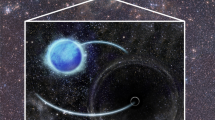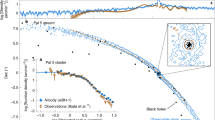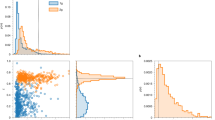Abstract
Hundreds of stellar-mass black holes probably form in a typical globular star cluster, with all but one predicted to be ejected through dynamical interactions1,2,3. Some observational support for this idea is provided by the lack of X-ray-emitting binary stars comprising one black hole and one other star (‘black-hole/X-ray binaries’) in Milky Way globular clusters, even though many neutron-star/X-ray binaries are known4. Although a few black holes have been seen in globular clusters around other galaxies5,6, the masses of these cannot be determined, and some may be intermediate-mass black holes that form through exotic mechanisms7. Here we report the presence of two flat-spectrum radio sources in the Milky Way globular cluster M22, and we argue that these objects are black holes of stellar mass (each ∼10–20 times more massive than the Sun) that are accreting matter. We find a high ratio of radio-to-X-ray flux for these black holes, consistent with the larger predicted masses of black holes in globular clusters compared to those outside8. The identification of two black holes in one cluster shows that ejection of black holes is not as efficient as predicted by most models1,2,4, and we argue that M22 may contain a total population of ∼5–100 black holes. The large core radius of M22 could arise from heating produced by the black holes9.
This is a preview of subscription content, access via your institution
Access options
Subscribe to this journal
Receive 51 print issues and online access
$199.00 per year
only $3.90 per issue
Buy this article
- Purchase on Springer Link
- Instant access to full article PDF
Prices may be subject to local taxes which are calculated during checkout



Similar content being viewed by others
References
Kulkarni, S. R., Hut, P. & McMillan, S. Stellar black holes in globular clusters. Nature 364, 421–423 (1993)
Sigurdsson, S. & Hernquist, L. Primordial black holes in globular clusters. Nature 364, 423–425 (1993)
Portegies Zwart, S. F. & McMillan, S. L. W. Black hole mergers in the universe. Astrophys. J. 528, L17–L20 (2000)
Kalogera, V., King, A. R. & Rasio, F. A. Could black hole X-ray binaries be detected in globular clusters? Astrophys. J. 601, L171–L174 (2004)
Maccarone, T. J., Kundu, A., Zepf, S. E. & Rhode, K. L. A black hole in a globular cluster. Nature 445, 183–185 (2007)
Irwin, J. A., Brink, T. G., Bregman, J. N. & Roberts, T. P. Evidence for a stellar disruption by an intermediate-mass black hole in an extragalactic globular cluster. Astrophys. J. 712, L1–L4 (2010)
Portegies Zwart, S. F., Baumgardt, H., Hut, P., Makino, J. & McMillan, S. L. W. Formation of massive black holes through runaway collisions in dense young star clusters. Nature 428, 724–726 (2004)
Belczynski, K. et al. On the maximum mass of stellar black holes. Astrophys. J. 714, 1217–1226 (2010)
Mackey, A. D., Wilkinson, M. I., Davies, M. B. & Gilmore, G. F. Black holes and core expansion in massive star clusters. Mon. Not. R. Astron. Soc. 386, 65–95 (2008)
Strader, J. et al. No evidence for intermediate-mass black holes in globular clusters: strong constraints from the VLA. Astrophys. J. 750, L27 (2012)
McLaughlin, D. & van der Marel, R. Resolved massive star clusters in the Milky Way and its satellites: brightness profiles and a catalog of fundamental parameters. Astrophys. J. Suppl. Ser. 161, 304–360 (2005)
Monaco, L., Pancino, E., Ferraro, F. R. & Bellazzini, M. Wide-field photometry of the Galactic globular cluster M22. Mon. Not. R. Astron. Soc. 349, 1278–1290 (2004)
Maccarone, T. & Knigge, C. Compact objects in globular clusters. Astron. Geophys. 48, 5.12–5.20 (2007)
Gallo, E., Fender, R. P. & Hynes, R. I. The radio spectrum of a quiescent stellar mass black hole. Mon. Not. R. Astron. Soc. 356, 1017–1021 (2005)
Anderson, J. et al. The ACS survey of Galactic globular clusters. V. Generating a comprehensive star catalog for each cluster. Astron. J. 135, 2055–2073 (2008)
Maccarone, T. J. Do X-ray binary spectral state transition luminosities vary? Astron. Astrophys. 409, 697–706 (2003)
Gallo, E., Fender, R. P. & Pooley, G. G. A universal radio-X-ray correlation in low/hard state black hole binaries. Mon. Not. R. Astron. Soc. 344, 60–72 (2003)
Gallo, E. et al. A radio-emitting outflow in the quiescent state of A0620–00: implications for modelling low-luminosity black hole binaries. Mon. Not. R. Astron. Soc. 370, 1351–1360 (2006)
Miller-Jones, J. C. A., Jonker, P. G., Maccarone, T. J., Nelemans, G. & Calvelo, D. E. A deep radio survey of hard state and quiescent black hole X-Ray binaries. Astrophys. J. 739, L18 (2011)
Miller-Jones, J. C. A. et al. Zooming in on a sleeping giant: milliarcsecond High Sensitivity Array imaging of the black hole binary V404 Cyg in quiescence. Mon. Not. R. Astron. Soc. 388, 1751–1758 (2008)
Corbel, S., Tomsick, J. A. & Kaaret, P. On the origin of black hole X-Ray emission in quiescence: Chandra observations of XTE J1550–564 and H1743–322. Astrophys. J. 636, 971–978 (2006)
Merloni, A., Heinz, S. & di Matteo, T. A fundamental plane of black hole activity. Mon. Not. R. Astron. Soc. 345, 1057–1076 (2003)
Remillard, R. A. & McClintock, J. E. X-ray properties of black-hole binaries. Annu. Rev. Astron. Astrophys. 44, 49–92 (2006)
Tauris, T. M. & van den Heuvel, E. P. J. in Compact Stellar X-ray Sources (eds Lewin, W. H. G. & van der Klis, M. ) 623–665 (Cambridge Univ. Press, 2006)
Ivanova, N. et al. Formation of black hole X-ray binaries in globular clusters. Astrophys. J. 717, 948–957 (2010)
Repetto, S., Davies, M. B. & Sigurdsson, S. Investigating stellar-mass black hole kicks. Mon. Not. R. Astron. Soc. (in the press); preprint at http://arXiv.org/abs/1203.3077 (2012)
Lynch, R. S., Ransom, S. M., Freire, P. C. C. & Stairs, I. H. Six new recycled globular cluster pulsars discovered with the Green Bank Telescope. Astrophys. J. 734, 89 (2011)
Migliari, S. & Fender, R. P. Jets in neutron star X-ray binaries: a comparison with black holes. Mon. Not. R. Astron. Soc. 366, 79–91 (2006)
Körding, E. G., Knigge, C., Tzioumis, T. & Fender, R. Detection of radio emission from a nova-like cataclysmic variable: evidence of jets? Mon. Not. R. Astron. Soc. 418, L129–L132 (2011)
Acknowledgements
The National Radio Astronomy Observatory is a facility of the National Science Foundation operated under cooperative agreement by Associated Universities, Inc. L.C. is a Jansky Fellow of the National Radio Astronomy Observatory. This work is partially based on observations made with the NASA/ESA Hubble Space Telescope, and obtained from the Hubble Legacy Archive, which is a collaboration between the Space Telescope Science Institute (STScI/NASA), the Space Telescope European Coordinating Facility (ST-ECF/ESA) and the Canadian Astronomy Data Centre (CADC/NRC/CSA).
Author information
Authors and Affiliations
Contributions
J.S. wrote the text. L.C. reduced the data. All authors contributed to the interpretation of the data and commented on the final manuscript.
Corresponding author
Ethics declarations
Competing interests
The authors declare no competing financial interests.
Supplementary information
Supplementary Information
This file contains Supplementary Text, Supplementary References and Supplementary Figure 1. (PDF 159 kb)
Rights and permissions
About this article
Cite this article
Strader, J., Chomiuk, L., Maccarone, T. et al. Two stellar-mass black holes in the globular cluster M22. Nature 490, 71–73 (2012). https://doi.org/10.1038/nature11490
Received:
Accepted:
Published:
Issue Date:
DOI: https://doi.org/10.1038/nature11490
This article is cited by
-
A supra-massive population of stellar-mass black holes in the globular cluster Palomar 5
Nature Astronomy (2021)
-
HAYDN
Experimental Astronomy (2021)
-
Weighing stars from birth to death: mass determination methods across the HRD
The Astronomy and Astrophysics Review (2021)
-
The “dynamical clock”: dating the internal dynamical evolution of star clusters with Blue Straggler Stars
Rendiconti Lincei. Scienze Fisiche e Naturali (2020)
-
Size diversity of old Large Magellanic Cloud clusters as determined by internal dynamical evolution
Nature Astronomy (2019)
Comments
By submitting a comment you agree to abide by our Terms and Community Guidelines. If you find something abusive or that does not comply with our terms or guidelines please flag it as inappropriate.



